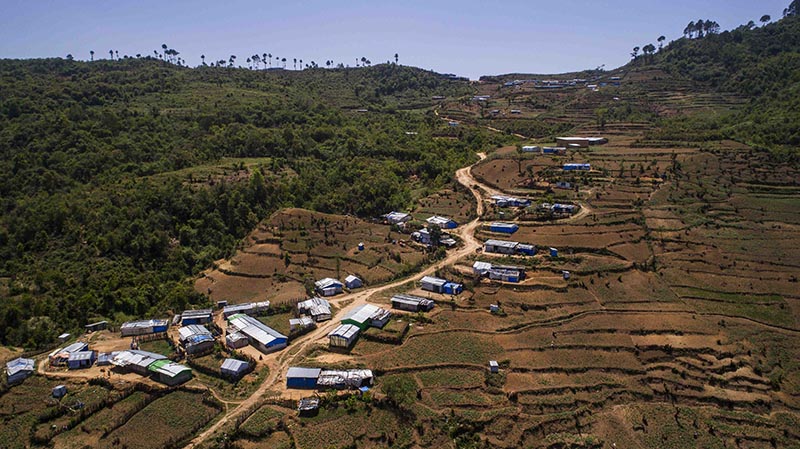Three years on, quake-displaced living on horns of dilemma
Selang (Sindhupalchowk), April 24
Even years after the devastating earthquake of April 25, 2015, scores of families displaced from villages in Sindhupalchok have not returned, though geologists have said it is safe for them to return to their plots of land and rebuild. Besides, there are some whose land was rendered inhabitable and are eligible to relocate elsewhere, but are undecided where to.
Shyam Gole, whose house in Golche village was destroyed by the massive earthquake is eligible to relocate to any safer area to build a new house, but he has not been able to decide where he should relocate.
Gole’s was among the 80 families from Golche who had moved to Baskharkha, Selang village, in Sindhupalchok, after the earthquake. Only seven families of Golche are eligible to be relocated to “safe areas”.
Most of the families, including Mingmar Dong’s, were declared ineligible to move to other areas because their land plots were found to be safe for habitation by geologists. But Mingmar and 12 other families did not want to return to their own locality, as Selang, which is close to the district headquarters and offers scenic beauty “is more accessible” than Golche.
According to Kamal Thapa, ward chair of Jugal Rural Municipality, 13 families from Golche have bought land plots in Selang and seven families, including Mingmar’s, have started rebuilding their houses.
But some Dalit families, who had also moved to Baskharka earlier, have returned to Golche and will rebuild their houses there. According to Thapa, the Dalit families returned to Golche for their livelihood.
The government is planning to resettle 50 families who were displaced from Selang in Baskharka. “We have decided to resettle the displaced people from our ward area in Baskharka. Gole can build his house in Baskharka only if authorities in Golche recommend that he can build his house there,” said Thapa. Eighty-three families were displaced from villages of Selang after the quake, of which 10 families have already been relocated in Jalbire area.
Fifty families will be resettled in Baskharka and they should be from Selang, and not from Golche and other villages, according to officials. Earlier, there were 465 displaced families in Baskharka, but only 152 families remain, while others have returned to where they came from.
“We have already requested the National Reconstruction Authority to resettle quake survivors in Baskharka,” Thapa said.
NRA CEO Yubraj Bhusal said the NRA wanted to resettle quake survivors in Baskharka as soon as possible. “We’ll distribute land certificates when we receive the report from rural municipalities of the displaced. Only after that can they reconstruct their houses.”
Quake survivors who have yet to get land plots will get Rs 200,000 in grant from the government to buy a piece of land, apart from the Rs 300,000 housing aid that they are entitled to. According to the NRA, it will make arrangements for integrated settlement if “10 families come together and show interest” in the same.
“We have quake survivors even from Urleni who will be relocated to Kharanitar, Nuwakot. Around 348 families will be resettled at Kerauja in Gorkha. We have already identified 11 resettlement areas for integrated settlement across the country,” said Bhusal.
According to the NRA, the government has identified 3,794 beneficiaries from 280 settlements for relocating them to safer areas. Of them, 388 beneficiaries have already received Rs 200,000 in grant to relocate.
Bhusal estimated that around 650,000-700,000 houses would be rebuilt in 31 districts, though 767,705 households are eligible for grant.
Countrywide reconstruction update
- Constructed houses: 119,182
- Under-construction houses: 429,996
- Health centres: 586 constructed, 180 under construction
- Educational institutions: 3,157 constructed, 2,035 under construction
- Government buildings: 220 constructed temporarily, 147 under construction
- Archaeological heritage sites: 100 constructed, 329 under construction
- Drinking water infrastructure: 581 completed, 715 under construction






